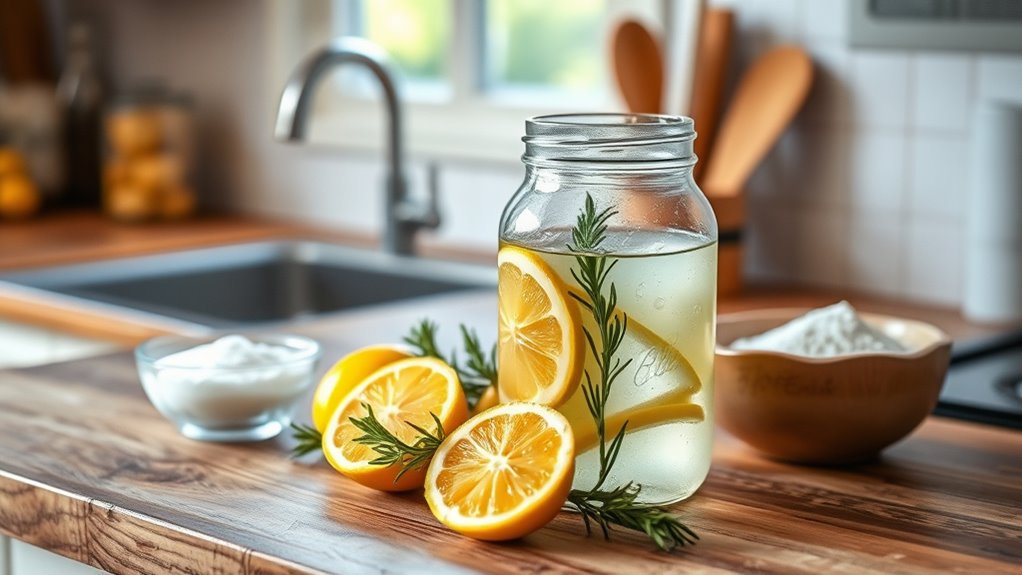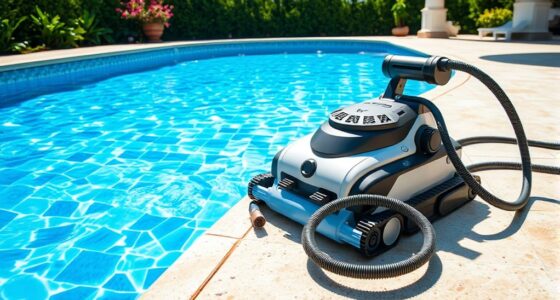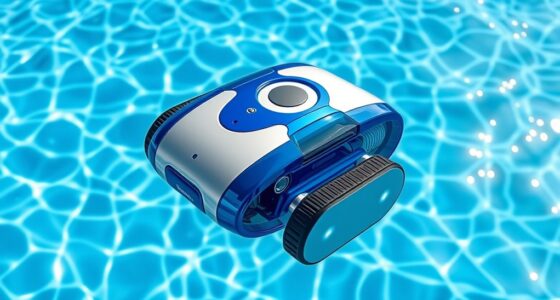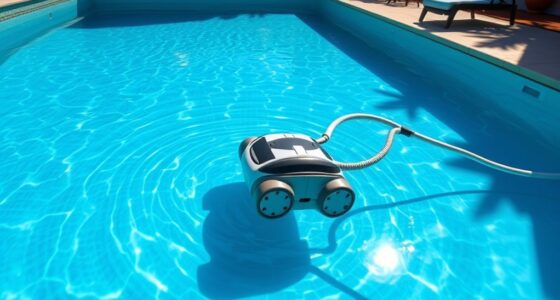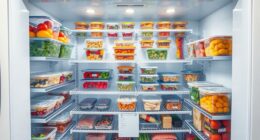For safe, simple, and effective DIY cleaners, you can use common ingredients like white vinegar, baking soda, and lemon juice. Mix equal parts vinegar and water for versatile surfaces, use baking soda as a gentle scrub or deodorizer, and add lemon juice for a fresh scent and extra cleaning power. These non-toxic solutions are budget-friendly, environmentally friendly, and perfect for multiple household tasks. Keep exploring to discover even more effective and natural cleaning tips.
Key Takeaways
- Use vinegar and water in equal parts for a safe, effective all-purpose cleaner suitable for many surfaces.
- Incorporate baking soda as a gentle abrasive and deodorizer for sinks, tubs, and trash cans.
- Add lemon juice for natural brightening, grease cutting, and a fresh citrus scent without chemicals.
- Avoid using acidic solutions on natural stone surfaces like marble or granite.
- Combine simple pantry ingredients to create cost-effective, non-toxic cleaners safe for family and the environment.
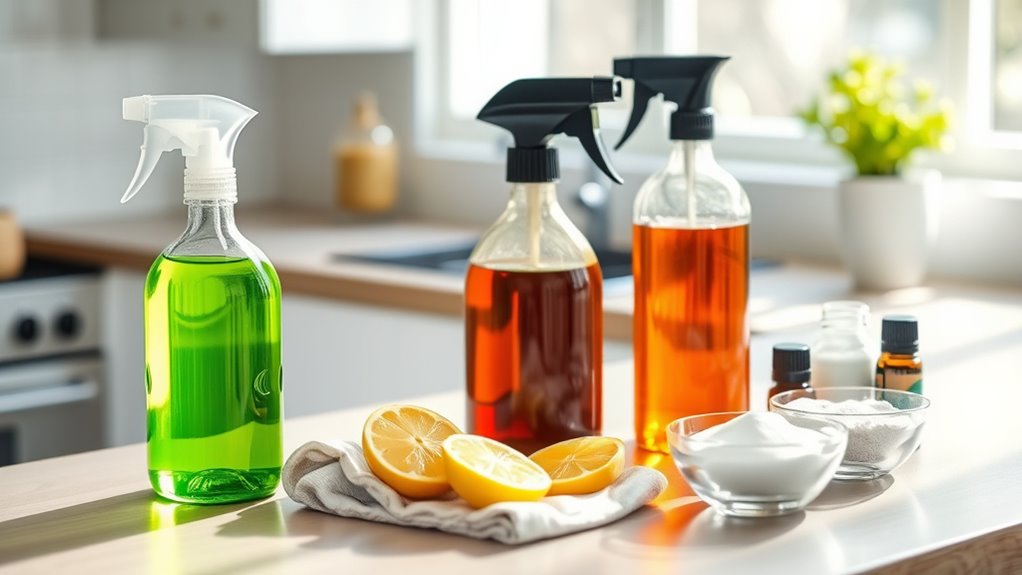
Cleaning your home doesn’t have to involve harsh chemicals or expensive store-bought products. In fact, many effective cleaners are right in your pantry or fridge, ready to help you keep your space spotless without risking your health or the environment. Making your own safe DIY cleaners is simple, cost-effective, and environmentally friendly. All you need are a few common ingredients, some basic tools, and a little know-how.
One of the easiest and most versatile DIY cleaners is a mixture of white vinegar and water. Vinegar is a natural disinfectant that cuts through grime, soap scum, and mineral deposits. To make this cleaner, combine equal parts of white vinegar and water in a spray bottle. Shake it up, and you’re ready to tackle kitchen counters, glass surfaces, and bathroom fixtures. Just avoid using vinegar on natural stone surfaces like marble or granite, as the acidity can cause damage. For those surfaces, opt for a gentle solution of dish soap and water instead.
Mix white vinegar and water for an effective, natural cleaner suitable for many surfaces—just avoid natural stone.
Baking soda is another powerhouse in your cleaning arsenal. It works as a mild abrasive that can scrub away stubborn stains, deodorize trash cans, and freshen up carpets. To create a simple all-purpose cleaner, sprinkle baking soda on surfaces or mix it with a small amount of water to form a paste. Apply it to sinks, tubs, or stovetops, and scrub gently with a sponge or brush. For deodorizing, sprinkle baking soda in your trash cans or carpets, let it sit for a while, then vacuum or rinse away. Baking soda is also great at neutralizing odors, making it a must-have for a non-toxic cleaning routine. Additionally, understanding toilet flushing mechanisms can help prevent unnecessary water waste during cleaning routines.
Lemon juice offers a natural way to brighten surfaces and cut through grease. Its fresh scent also leaves your home smelling clean and citrusy. Mix lemon juice with water for a quick glass cleaner or combine it with baking soda to form a paste for polishing metal fixtures. Plus, lemon’s natural acidity helps dissolve soap scum and hard water stains. Using lemon in your cleaning routine not only makes your home sparkle but also provides a fresh, clean scent that’s free from synthetic fragrances.
Frequently Asked Questions
Are DIY Cleaners Effective Against All Types of Stains?
DIY cleaners can be effective against many stains, but not all. For common spills like coffee, wine, or dirt, natural solutions like vinegar, baking soda, or lemon work well. However, stubborn or oil-based stains may require specialized commercial products. You should test your DIY cleaner on a small area first to prevent damage, and for tough stains, consider professional cleaning options to ensure proper removal.
How Long Do Homemade Cleaners Typically Last?
Most homemade cleaners last between one to three months, depending on ingredients. An interesting fact is that vinegar-based solutions can stay effective for up to six months if stored properly. You should store your DIY cleaners in airtight containers and keep them in a cool, dark place. Always check for signs of spoilage, like changes in smell or appearance, before using them to make sure they’re still safe and effective.
Can DIY Cleaners Replace Commercial Disinfectants Completely?
DIY cleaners can often replace commercial disinfectants for everyday use, but they may not be as effective against all germs and viruses. You should use them for routine cleaning and surface maintenance, especially since they’re non-toxic and eco-friendly. However, for high-risk areas like hospitals or during illness outbreaks, commercial disinfectants with proven efficacy are still your best choice. Always follow proper guidelines for maximum safety and effectiveness.
Are There Any Safety Precautions for Homemade Cleaners?
Yes, there are safety precautions you should take with homemade cleaners. Always label your containers clearly to prevent accidental misuse. Test your cleaner on a small area first to check for damage or discoloration. Keep your homemade solutions out of reach of children and pets, and store them in a cool, dry place. Use gloves if you’re handling ingredients that might irritate your skin, and avoid mixing harsh chemicals.
How Do I Store Homemade Cleaning Solutions Safely?
You should store homemade cleaning solutions like a hawk, in clearly labeled, airtight containers to prevent accidents. Keep them out of reach of children and pets, ideally in a cool, dark place away from food. Avoid storing near heat or direct sunlight, which can degrade ingredients. Regularly check for leaks or changes, and dispose of any unused solutions responsibly to keep your home safe and your DIY efforts effective.
Conclusion
Now that you know how easy and safe it is to make your own cleaners, why not give it a try? With simple ingredients and effective results, you can keep your home spotless without harmful chemicals. Isn’t it worth protecting your family and the environment while saving money? Embrace these DIY solutions and enjoy a cleaner, healthier space. After all, isn’t a safer, more natural home just a few simple steps away?
